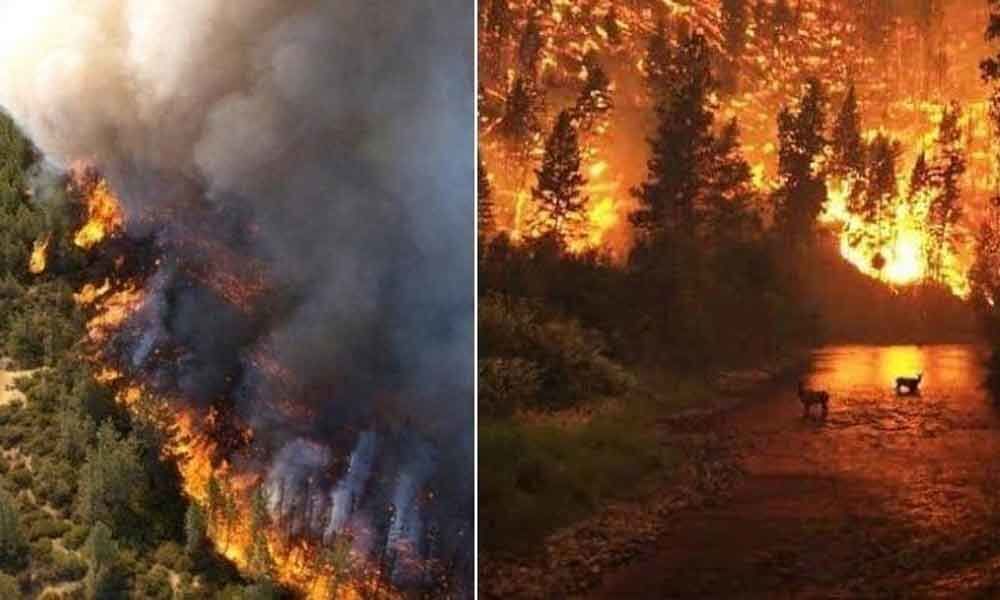Unprecedented: Arctic is burning, It's Fire and Ice!!

The eastern siberian scene does not regularly take after hellfire. In winter it is covered With snow ; summer, its forests are lush and its wetlands soggy.
The eastern siberian scene does not regularly take after hellfire. In winter it is covered With snow ; summer, its forests are lush and its wetlands soggy. This year, in any case, the region is ablaze, as are large parts of the Arctic Circle.
The planet's far North is on fire. This summer, more than 600 wildfires have devoured more than 2.4 million acres of Forest lands across Alaska. Fires are also ranging in northern Canada. In Siberia, stifling smoke from 13 million sections of land – a territory almost the size of West Virginia – is covering towns and urban areas.
The oceans are polluted, The arctic ice cap is melting, The amazonia is burning...
— Mohammed (@22______m) August 21, 2019
what's next ?#PrayforAmazonia pic.twitter.com/twleWu3TEo
Flames in these spots are typical. Yet, as concentrates here at the University of Alaska's International Arctic Research Center show, they are additionally unusual.
Recent flames are excessively frequent, serious and extreme. They are reducing older growth forest in favor of younger generation and emptying more carbon into the air when carbon dioxide fixations are establishing new precedents.
The #AmazonRainforest is burning.
— Dr. Jill Stein🌻 (@DrJillStein) August 21, 2019
The ARCTIC is burning.
July was the HOTTEST month on record.
Fossil fuel execs & their bought politicians are turning Earth into a burning hell.
We need to fight for the real #GreenNewDeal NOW! #SaveTheAmazon https://t.co/rjTHlF0VPz
Huge sub-Arctic timberlands
The boreal or taiga environment, a swath of northern timberland that spreads 17% of the globe's property zone, is adjusted to fire. It has been consuming consistently for a great many years. This tremendous scene is for the most part free of human streets, rail lines, electrical cables and urban areas. Blasts frequently spread until the breeze changes and the downpour falls.
On left what nature has bestowed beauty beyond words our life support machine and right what Bolso in Brazil is doing burning Amazon down - heart breaking soul destroying extinguishing our future on this Earth for without both Arctic and Amazon forest life on Earth will collapse pic.twitter.com/0gDMvzaNl7
— GO GREEN (@ECOWARRIORSS) August 21, 2019
Here in focal Alaska, our spindly tidy trees open resinous cones to kick off new seedlings when the parent tree is burned. Quickly developing fireweed and different blooms spread late consume scars. Before long a short time later come wild blueberries, willows and birch and aspen trees that shoot up from as yet living stumps and roots. In the end combustible conifers take over once more.
Normally, the cycle continues about like clockwork. Yet, today the cycles are about 25% shorter than previously, and that makes a huge difference.
The general increment in consuming can be difficult to distinguish and quantify in view of gigantic regular inconstancy. This present summer's flames in Alaska were driven by an exceptional early-season warmth wave. The connection between sweltering dry climate and fire is clear. Environmental change is causing a similarly clear pattern toward prior springs and more, more sweltering summers.
The Amazon is burning. The Arctic is burning. The climate emergency is here, now. How are you building with your communities to fight it, to face it? https://t.co/t0JIOD9Dym
— Emma Rae Lierley (@EmmaRaeLierley) August 22, 2019
Nonetheless, our state likewise has some cooler, wetter summers when almost no smoke gags the air. It isn't in every case simple to differentiate between normal year-to-year variances and unpropitious long haul shifts.
Boreal timberlands extend over the Northern Hemisphere from Alaska to Siberia.
A blasting North
Regardless, shifts are happening – driven by the exceptional warming that we are finding in Alaska. July 2019 currently remains as the most sizzling month at any point recorded in the state.
An unprecedented number of fires are burning north of the Arctic Circle in Greenland, Russia, Canada and Alaska. https://t.co/Gbp4FMb2Bl
— GZERO Media (@gzeromedia) August 19, 2019
A significant number of us, including atmosphere analysts, land chiefs, biologists, meteorologists, country and indigenous inhabitants and fire specialists, have been teaming up, concentrating this issue, gathering information, making recreations and PC models, utilizing satellite symbolism and getting outside to gauge precisely what's going on. In Alaska, state and government offices cooperate to screen and oversee fires through the Alaska Interagency Coordination Center and send firemen to the forefronts – including a record number of smoke-jumpers this year.
The proof demonstrates that in general, fires in the far North are increasing, more blazing and progressively visit. More seasoned conifers are losing ground to more youthful deciduous trees, adjusting entire biological systems. Burnt trees are discharging carbon, alongside soils wealthy in dead plant matter that are copying more profoundly than before. As these discharges fuel further warming, environmental change is causing more environmental change, which influences the whole planet.
Dangerously close
In Fairbanks, where I live, the human effects of this current summer's flames have been self-evident. As lightning activated blasts statewide in late June, the Shovel Creek Fire jumped up on the western edges of town. Air quality quickly weakened to "dangerous." Two neighborhoods were cleared, sending occupants to remain with companions or stay in my youngsters' school. Dislodged sled canine groups were housed at the neighborhood carnival.
The Arctic is on fire 🔥 "..in Alaska we have hundreds of wildfires, .. but this is what blows my mind .. in Russia we're talking about 2.7 million hectares of remote forest currently burning.."
— Chris Marquardt (@chrismarquardt) August 13, 2019
Henry @aguycalledpaul talks about the Arctic wildfires. https://t.co/yWmfV07hWV pic.twitter.com/eKignnvaVl
On certain days in June and July the smoke in Fairbanks was thick to the point that my neighbor, who has asthma, needed to wear a respirator veil. Another companion who has heart inconvenience needed to take asylum in a little meeting room at the emergency clinic that was offered as a sifted air security zone.
Shouldn't these flames be averted, and smothered when they happen? Shockingly, it isn't so straightforward. To begin with, the expense of firefighting crosswise over tremendous locales of the Arctic and sub-Arctic would be galactic, as Russian authorities have contended in light of open requests for activity to control fierce blazes in Siberia.
Second, putting out flames presently leaves substantially more exceptionally combustible fuel on the scene for one year from now or the year after – an issue that many fault for cataclysmic flames in different states. Fire administrators in Alaska, in association with land proprietors, rather have set needs for firefighting. Grounds are gathered in four classifications: restricted, changed, full and basic. By a wide margin the biggest portion is grouped "constrained," implying that flames in these territories are observed yet permitted to consume uninhibitedly where they don't compromise lives or known assets.
The Arctic is burning from Alaska🇺🇸 to Siberia 🇷🇺.
— Erik Solheim (@ErikSolheim) August 4, 2019
Ravaged by hundreds of wildfires after the warmest June ever.
Time for climate action!
pic.twitter.com/3AY02XmEaM
Yet, when flames compromise homes and lives, they are battled wildly. After energetic endeavors by flame groups from Alaska and the Lower 48, emptied Fairbanks occupants got an all-reasonable on July 10. Individuals returned home, and there were no wounds.
August carried downpours to hose our nearby carnival, which were at last being utilized for family fun instead of lodging uprooted pets. I haven't heard much grumbling. Wet climate has appeared on time here, and we're thankful. In any case, we understand that other Arctic districts are as yet consuming, and that fire is something other than a neighborhood issue for us all.















